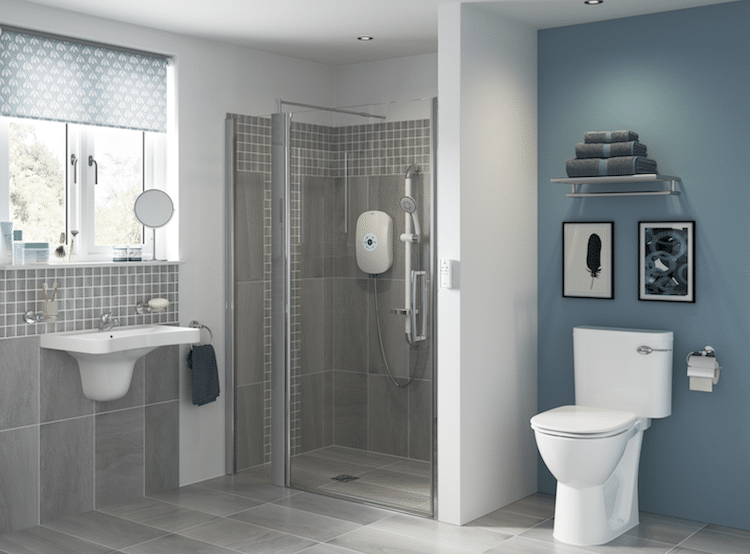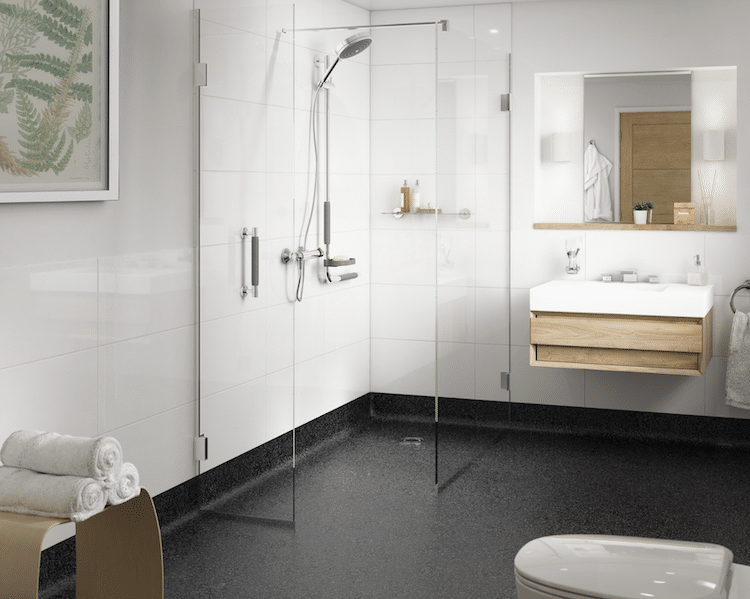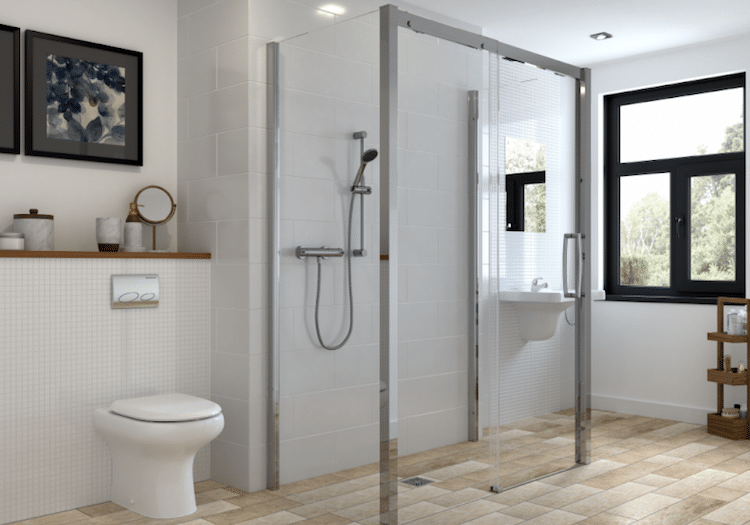Updated August 2024
In the UK, over 1.2 million people use wheelchairs, which is expected to increase as the population grows. As a result, making bathrooms wheelchair accessible is crucial in supporting the independence of wheelchair users.
At Age Care Bathrooms, we understand it can be difficult to decide which type of accessible bathroom is right for you, your mobility needs, budget, and bathroom layout. Our incredible team is here to help you find the right solution.
Let’s explore some of the most useful accessibility fittings available to make your bathroom more wheelchair friendly.
If you need a wet room due to mobility concerns or a disability, please don’t hesitate to contact us today.
Wheelchair Accessible Bathroom Features
When designing a wheelchair friendly bathroom, various factors must be taken into consideration. It’s important to remember that style does not have to be sacrificed in favour of comfort. You can have a stylish bathroom with all of the mobility aids and bathroom fittings you want.
It all starts with knowing your wheelchair size.
The height and width of a wheelchair’s seat are key comfort features since they affect how the user is positioned in the wheelchair. A width that is too wide for the user’s size might result in poor posture and unintended seat position adjustments. Pressure sores and movement difficulties may also result from a wheelchair that is too low in height and too narrow in width.
When designing your bathroom, our designers will make sure it’s accessible for someone using a wheelchair, allowing for easy entry and movement. We also plan for the installation of grab bars and safety rails, even if they’re not needed right now.
Once you find the right wheelchair for your mobility needs, you can start to look at the key features your bathroom needs to better support you while ensuring it’s wheelchair friendly.

Designing a Wheelchair Friendly Bathroom
A range of modifications can be made to a bathroom to improve its accessibility for wheelchair users. Here are the key features we can install to make your bathroom more wheelchair accessible.
Wheelchair Accessible Toilets
Installing a wheelchair accessible toilet is one of the most crucial modifications needed to enhance a bathroom’s accessibility.
These toilets are typically taller than standard, with a seat height of 17-19 inches, and have armrests or grab bars for added support. Although this may not sound like a lot, if you find it difficult to use a standard toilet, it can make a big difference in supporting you.
Wheelchair accessible toilets are designed to be easier to use for those with reduced mobility or simply to provide a more comfortable height when transferring from a wheelchair. The most comfortable toilet height for you will largely depend on personal preference and your chair height.
During the fitting process, we ensure your toilet is fitted first, meaning you will never be without one for more than a few hours.
Wheelchair Accessible Showers and Baths
We install specialised units for wheelchair users for showering and bathing, both of which are designed to improve the bathing experience, no matter your mobility needs:
- Level Access Showers — Also known as wet rooms, our level access showers are wheelchair friendly due to having no steps or trays. With our selection of level-access showers you can add a shower chair or lounging area.
Level access showers require very little maintenance. In addition to providing step-free access, wet rooms with glass panels help insulate the area for better energy efficiency. They also protect the home’s walls and structure from leaks and mould. - Walk-In Baths — For those who can gently lift themselves carefully into a bath, a walk-in tub is a bath that has a door on the side, allowing individuals to get in and out of the tub rather than having to step over the side.
They can be especially helpful for individuals who have mobility limitations that make it difficult to step over the side of a standard tub. Walk-in baths are available in full-length or deep soak sizes, and can be equipped with features such as jets, heated surfaces, and handheld showers. They also have incredible therapeutic benefits, relax your muscles and reduce aches and pains.

Handheld Showerheads
A handheld showerhead can be held in your hand, allowing you to direct the water spray wherever you need it. This is a popular choice to be fitted in walk-in baths or level-access showers, where a chair is.
They can be especially helpful for individuals who have mobility limitations that make it difficult to reach certain areas of the body. Handheld showerheads can be attached to a fixed showerhead or used as a standalone unit for a seamless addition to your wheelchair accessible bathroom.
Shower Seats
A shower seat is a seat that is designed to be used in the shower. It allows individuals to sit down while showering. Shower seats can be made of plastic, aluminium, or stainless steel, and some models are designed to be portable so they can be taken on trips.
Grab Bars and Support Rails
Grab bars are installed in wheelchair accessible bathrooms for individuals to hold onto for support while bathing or using the toilet. With grab handles it’s important to make sure that they are properly installed at hip height and securely anchored to the wall to ensure their stability.
Grab bars and safety rails should be equipped in the areas where people with mobility issues are most likely to need them, for example, next to the toilet and in the bath or shower area.
Slip-Resistant Surfaces
Steer clear of glazed tiles to prevent slick floors. Use Vinyl Altro or Polyflor anti-slip flooring as an alternative for a safer surface, and add slide mats for the added traction to shower stalls and wet rooms.
Storage Areas and Shelves
Placing shelves and storage in accessible locations is essential to reduce needless bending and stretching. We always avoid positioning shelves and storage areas too high or too low. Under or by the sink are popular storage locations for ease of access.
Accessible Basins
Like a raised toilet, a raised wall-mounted concave-shaped basin will have space for a stool underneath it, and it will need less bending for those who have problems doing so. Ensure that faucets, levers, and taps are simple to use, or think about replacing them with motion sensors or buttons.

Get Expert Bathroom Solutions from Age Care Bathrooms
Our team of experts is here to support you in getting the accessible bathroom of your dreams, no matter your mobility needs. Our range of wet rooms, walk-in baths, and mobility aids can be fitted in a bathroom to improve its accessibility for wheelchair users.
It’s important to consider your needs and preferences when selecting modifications for accessibility purposes. We recommend working with a healthcare professional or occupational therapist to determine the best options for your wheelchair accessible bathroom.
If you are looking to create a bathroom that is wheelchair accessible, contact us today!
If you need a walk-in bath due to mobility concerns or a disability, please don’t hesitate to contact us today.













